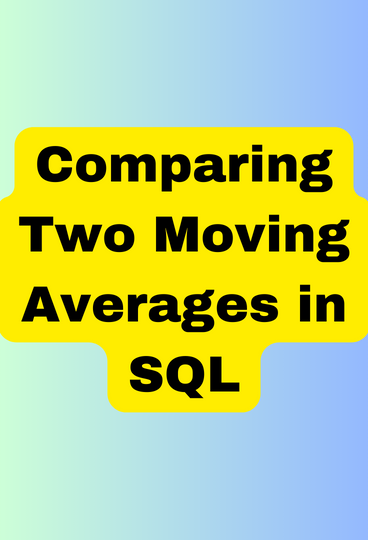Comparing Two Moving Averages in SQL
The Sample Dataset
Let's work with a simplified product sales dataset. Here's a snippet of the table structure:
productid productname supplierid categoryid unitprice discontinued
1 Product HHYDP 1 1 18.00 0
2 Product RECZE 1 1 19.00 0
3 Product IMEHJ 1 2 10.00 0
4 Product KSBRM 2 2 22.00 0
5 Product EPEIM 2 2 21.35 1
6 Product VAIIV 3 2 25.00 0
7 Product HMLNI 3 7 30.00 0
8 Product WVJFP 3 2 40.00 0
9 Product AOZBW 4 6 97.00 1
10 Product YHXGE 4 8 31.00 0
Calculating Moving Averages
We'll calculate the moving average of the `unitprice` for each product. For simplicity, let's calculate a 3-day moving average. Here's the T-SQL code for it:
SELECT
productid,
productname,
unitprice,
LAG(unitprice, 1)
LAG(unitprice, 2)
AVG(unitprice)
FROM [Production].[Products]
In this query, we use the `LAG` function to fetch the unit price for the previous days (day1 and day2) and the `AVG` window function to calculate the 3-day moving average.
Advantages and Disadvantages
Advantages:
1. Data Insights: Moving averages provide a smooth trendline, making it easier to spot trends and patterns in your data.
2. Noise Reduction: Moving averages help reduce the impact of daily fluctuations, making it simpler to identify underlying trends.
3. Decision Support: Comparing two moving averages can help you make data-driven decisions, such as when to buy or sell products based on their price trends.
Disadvantages:
1. Delayed Signals: Moving averages can be slow to respond to rapid changes in data since they smooth the data over a specific time period.
2. Complex Queries: Calculating moving averages can be computationally intensive, especially for large datasets.
Best Practices
- Choose the right moving average type (e.g., simple, exponential) based on the nature of your data.
- Select an appropriate time window for your moving averages; this depends on the specific problem you are addressing.
- Regularly update your moving averages to ensure they reflect current trends.
Use Cases
-Stock Market Analysis: Traders use moving averages to predict future stock prices.
- Demand Forecasting: Businesses use moving averages to predict future product demand.
- Web Traffic Analysis: Website owners use moving averages to understand user engagement trends.
- Quality Control: Manufacturers use moving averages to monitor product quality over time.



.png)




.png)
.jpg)
.png)


.png)
